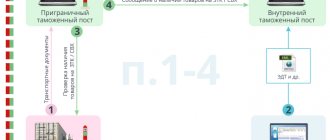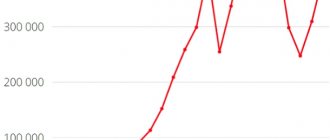MOSCOW, February 6. /TASS/. The positive trade balance of the Russian Federation at the end of 2021 amounted to $211.6 billion, which is 1.6 times ($80.6 billion) higher than the figure for 2021, follows from the materials of the Federal Customs Service (FCS).
Exports of goods during the reporting period increased by 25.6% to $452.1 billion, imports by 5.1% to $240.5 billion.
Thus, over the past year, the foreign trade turnover of the Russian Federation increased by 17.6% and amounted to $692.6 billion.
The basis of Russian exports has traditionally been fuel and energy products, the share of which was 63.7% (2017 - 59.3%). The share of metals and products made from them accounted for 9.9% (10.4%), chemical products - 6.1%, machinery and equipment - 6.5%, food products and raw materials for their production - 5.5%, timber and pulp and paper products - 3.1%.
In the commodity structure of imports, machinery and equipment accounted for 47.3%. At the same time, the physical volume of imports of passenger cars increased by 9.5%, and trucks decreased by 17.9%. Products of the chemical industry accounted for 18.3%, food products and raw materials for their production - 12.4%, metals and products made from them - 7.2%, textiles and footwear - 6.2%.
Russia's main trading partners in 2021 were: China, trade turnover with which amounted to $108.3 billion (an increase of 24.5% compared to 2017), Germany - $59.6 billion (+19.3%), the Netherlands - $47, 2 billion (+19.4%), Italy - $27 billion (+12.7%), Turkey - $25.6 billion (+15.7%), USA - $25 billion (+7.9%), Republic of Korea - $24.8 billion (+29.1%), Poland - $21.7 billion (+31%), Japan - $21.3 billion (+17%) and France - $17.2 billion (+11.2%) .
Export of oil and petroleum products
Russian oil exports in value terms in 2021 increased by 38.2% compared to the same period in 2021 and amounted to $129 billion. The physical volume of oil exports increased by 2.9% during the reporting period and amounted to 260 million tons.
According to the Federal Customs Service, in December last year the cost of oil sold decreased by 10.7% compared to December 2021 - to $10.5 billion.
Russia's revenues from the export of petroleum products last year increased by 34.1% compared to 2021 - to $78.1 billion.
Revenues from the sale of gasoline increased by 19.3%, to $2.486 billion, and from the sale of diesel fuel - by 42.9%, to $33.1 billion.
The volume of exports of petroleum products during the reporting period increased by 1.1%, to 150 million tons.
Russia's trading partners
The main trading partners of Russia in the 1st quarter of 2018
were China (15.3023% of Russia’s total foreign trade turnover), Germany (9.0027%), the Netherlands (7.3754%), Belarus (5.0836%), Turkey (4.5685%), Italy (3. 7250%), United States (3.2799%), Poland (3.2239%), Japan (2.8438%), Kazakhstan (2.7160%), Republic of Korea (2.6657%), France (2. 6538%), Finland (2.3452%), Great Britain (2.1408%), Ukraine (2.1395%), Belgium (2.0184%), India (1.4503%), Czech Republic (1.1705% ), Egypt (1.0558%), Taiwan (1.0248%), Austria (0.9582%), Hungary (0.9509%), Spain (0.9016%), Sweden (0.8818%), Slovakia (0.8275%), Lithuania (0.8125%), Denmark (0.8083%), Romania (0.8014%), Switzerland (0.7987%) and Latvia (0.7778%).
Russia's main trading partners in the 1st quarter of 2021 were China (14.3387% of Russia's total foreign trade turnover), Germany (8.9955%), the Netherlands (8.0690%), Belarus (4.9871%), Italy (3 .9550%), United States (3.8612%), Republic of Korea (3.4085%), Turkey (3.2160%), Japan (3.0661%), Kazakhstan (2.9912%), Poland (2 .9019%), France (2.5685%), Finland (2.1904%), Great Britain (2.1526%), Ukraine (2.0130%), Belgium (1.9044%), India (1.5204 %), Latvia (1.3166%), Czech Republic (1.2115%), Switzerland (1.0878%), Slovakia (0.9892%), Taiwan (0.9786%), Spain (0.9672%) , Hungary (0.9560%), Singapore (0.9389%), Brazil (0.7995%), Sweden (0.7921%), Vietnam (0.7662%), Greece (0.7635%) and Romania (0.7592%).
Largest share in Russian exports in the 1st quarter of 2018
occupied by China (11.9139% of total Russian exports), the Netherlands (10.4689%), Germany (8.0005%), Turkey (6.0205%), Belarus (4.9449%), Poland (3.8213 %), Italy (3.3978%), Kazakhstan (2.9645%), Finland (2.8037%), Republic of Korea (2.6500%), United States (2.5541%), Belgium (2.5142 %), Japan (2.5096%), UK (2.3224%), Ukraine (2.0332%), France (1.6067%), India (1.4919%), Egypt (1.4289%) , Malta (1.1670%), Lithuania (1.1286%), Taiwan (1.1174%), Latvia (1.0869%), Denmark (1.0210%), Czech Republic (0.9732%), Hungary (0.9586%), Austria (0.9183%), Greece (0.8984%), Sweden (0.8561%), Romania (0.8322%) and Slovakia (0.7847%).
The largest share in Russian exports in the 1st quarter of 2021 was occupied by the Netherlands (11.5407% of total Russian exports), China (10.7416%), Germany (8.2679%), Belarus (4.7209%), Turkey (4 .2456%), Italy (3.8226%), Republic of Korea (3.6969%), Poland (3.3547%), Kazakhstan (3.1812%), United States (2.9248%), Japan (2 .7337%), Finland (2.6282%), Great Britain (2.2754%), Belgium (2.2408%), France (2.0052%), Latvia (1.9324%), Ukraine (1.9270 %), India (1.5417%), Singapore (1.3011%), Switzerland (1.1624%), Greece (1.1315%), Czech Republic (1.0839%), Taiwan (1.0714%) , Slovakia (1.0058%), Bulgaria (1.0007%), Egypt (0.9722%), Malta (0.9051%), Hungary (0.8771%), Denmark (0.8163%) and Lithuania (0.7672%).
The largest share in Russian imports in the 1st quarter of 2018
occupied by China (21.6945% of total Russian imports), Germany (10.8932%), Belarus (5.3452%), the United States (4.6491%), France (4.6293%), Italy (4. 3422%), Japan (3.4743%), Republic of Korea (2.6953%), Ukraine (2.3400%), Kazakhstan (2.2472%), Poland (2.0970%), Turkey (1.8293 %), Great Britain (1.7981%), Czech Republic (1.5428%), Netherlands (1.5394%), Vietnam (1.4879%), Finland (1.4803%), Spain (1.3972%) , India (1.3717%), Switzerland (1.0846%), Belgium (1.0830%), Brazil (1.0738%), Austria (1.0335%), Hungary (0.9364%), Sweden (0.9301%), Slovakia (0.9083%), Taiwan (0.8502%), Indonesia (0.7957%), Romania (0.7432%) and Thailand (0.7336%).
The largest share in Russia's imports in the 1st quarter of 2021 was occupied by China (20.9685% of total Russian imports), Germany (10.3366%), the United States (5.5871%), Belarus (5.4776%), Italy ( 4.1990%), Japan (3.6788%), France (3.6066%), Republic of Korea (2.8770%), Kazakhstan (2.6409%), Ukraine (2.1715%), Poland (2 .0673%), Great Britain (1.9263%), Netherlands (1.6704%), Vietnam (1.4926%), India (1.4811%), Czech Republic (1.4468%), Spain (1.4364 %), Brazil (1.4148%), Finland (1.3836%), Turkey (1.3183%), Belgium (1.2844%), Indonesia (1.1417%), Hungary (1.1013%) , Slovakia (0.9586%), Switzerland (0.9502%), Austria (0.9106%), Sweden (0.8997%), Romania (0.8168%), Taiwan (0.8077%) and Ecuador (0.7717%).
Export of ferrous metals
Russia's exports of ferrous metals in 2021 increased in value terms by 24.2% compared to the previous year, to $23.36 billion.
In physical terms, exports of ferrous metals over the year increased by 9.2%, to 46.4 million tons.
According to the Federal Customs Service, income from Russian copper exports in 2021 increased by 13.1% compared to 2021, to $4.1 billion, income from nickel exports - by 25.3%, to $1.7 billion. In physical terms Copper exports from Russia over the year increased by 10.5%, to 652.2 thousand tons, nickel - decreased by 0.9%, to 135.1 thousand tons.
Import of goods and services from Russia
As for imports, Russia largely purchases the same machinery and equipment - $112.6 billion or 41.56%. We have identified 5 main import items from Russia:
1. MACHINERY AND EQUIPMENT - more than $112.6 billion or 41.56% 2. MECHANICAL EQUIPMENT - more than $43.6 billion or 16.09% 3. ELECTRICAL EQUIPMENT - more than $29.9 billion or 11.04% 4. PLASTICS AND PRODUCTS – more than $9.7 billion or 3.6% 5. MEDICINES – more than $8 billion or 2.99%
Aluminum export
Aluminum exports from the Russian Federation last year in value terms increased by 2.7%, to $5.35 billion, compared to 2021, the materials say. In physical terms, aluminum exports from Russia in 2018 decreased by 1.3% compared to 2021, to 3.06 million tons.
The largest producer of primary aluminum in Russia is Rusal. In 2021, Rusal produced 3.7 million tons of primary aluminum. Before the sanctions, the company exported more than 80% of its products (the EU accounted for 45%, the USA, Asia and the domestic market - 18% each). Sanctions against the company were lifted on January 27, 2021, Washington time (January 28, Moscow time).
The volume of Russia's foreign trade turnover at the end of 2021 amounted to 693 billion dollars, with exports amounting to 444 billion, imports 249 billion. In terms of the excess of exports over imports, Russia currently ranks 3rd, behind only China and Germany.
Trend #1. Dynamics: exports are growing faster than imports
After the crisis year of 2021, Russian exports in 2017-2018 growing by 25% annually, but has still not surpassed the 2012 high of $527 billion. If the current growth trend continues, by the end of 2021 we can expect exports to reach $555 billion.
Import dynamics show a less impressive result: last year it grew by only 4.6%, which is due to low consumer demand (see Figure 1).
The growth of foreign exchange earnings from foreign trade and the predominance of exports over imports indicates the competitiveness of export goods, the availability of import-substituting products, and the possibilities of replenishing the country's budget.
Figure 1. Dynamics of Russian exports, billion US dollars
Trend No. 2. Goods: the share of non-primary products in exports is growing
The structure of Russian exports is traditionally dominated by fuel and raw materials, whose share in 2021 amounted to 63.8%. For comparison, in the successful pre-crisis year of 2013, the share of oil and gas in total exports was more than 70%. The decrease is small, but the fact itself indicates a gradual change in product groups of Russian products supplied to the international market and a decrease in the share of raw materials.
Imports mainly consist of recycled goods - mechanical equipment, electrical machines, land transport, pharmaceutical products (see Table 1).
The greater the share of non-commodity exports, the more obvious the recognition of the quality of domestic goods on the international market, the less dependence on fluctuations in world prices for raw materials and the more stable the economy.
Table 1. Structure of Russian exports and imports in 2021 by main product groups
| EXPORT | IMPORT | ||||||
| Rank | Product group | Volume, billion US dollars | Share in total volume, % | Rank | Product group | Volume, billion US dollars | Share in total volume, % |
| 1 | Mineral fuel | 286,7 | 63,8 | 1 | Mechanical equipment | 43,6 | 18,3 |
| 2 | Black metals | 23,4 | 5,2 | 2 | Electrical machines and equipment | 29,9 | 12,6 |
| 3 | Armament | 10,5 | 2,3 | 3 | Ground transport, other than rail | 23,7 | 10,0 |
| 4 | Cereals | 10,5 | 2,3 | 4 | Pharmaceutical products | 10,6 | 4,4 |
| 5 | Jewelry, precious metals | 10,1 | 2,2 | 5 | Plastics and products made from them | 9,8 | 4,1 |
| 6 | Mechanical equipment, nuclear reactors | 9,2 | 2,0 | 6 | Optical instruments and apparatus | 6,7 | 2,8 |
| 7 | Wood and wood products | 9,0 | 2,0 | 7 | Armament | 6,6 | 2,8 |
| 8 | Fertilizers | 8,2 | 1,8 | 8 | Ferrous metal products | 5,8 | 2,4 |
| 9 | Aluminum and products made from it | 6,6 | 1,5 | 9 | Black metals | 5,3 | 2,2 |
| 10 | Copper and products made from it | 5,4 | 1,2 | 10 | Edible fruits and nuts | 5,1 | 2,1 |
| Other products | 69,9 | 15,6 | Other products | 91,1 | 38,2 | ||
Trend #3. Partners and countries: stable foreign trade relations are maintained
The European Union remains Russia's leading trading partner both in exports - 46.1% of the total volume, and in imports - 35.8%. The second and third places of the most significant countries in trade are occupied by China and the EAEU bloc (see Table 2). If we consider the rating outside of economic associations, then the PRC becomes the undisputed leader - the volume of mutual trade for the first time in history exceeded the $100 billion mark.
Sanctions and pressure on Russia’s foreign trade partners had no impact: a reliable, mutually beneficial partnership wins the confrontation with the political situation.
Table 2. Main directions of Russian exports by country and economic association, 2021
| EXPORT | IMPORT | ||||||
| Rank | Country, economic association | Volume, billion US dollars | Share in total volume, % | Rank | Country, economic association | Volume, billion US dollars | Share in total volume, % |
| 1 | EU | 204,9 | 46,1 | 1 | EU | 89,3 | 35,8 |
| 2 | CHINA | 56,0 | 12,6 | 2 | CHINA | 52,2 | 21,0 |
| 3 | EAEU | 37,7 | 8,5 | 3 | EAEU | 18,4 | 7,4 |
| 4 | Türkiye | 21,3 | 4,8 | 4 | USA | 12,5 | 5,0 |
| 5 | SOUTH KOREA | 17,8 | 4,0 | 5 | JAPAN | 8,8 | 3,5 |
| 6 | USA | 12,5 | 2,8 | 6 | SOUTH KOREA | 7,0 | 2,8 |
| 7 | JAPAN | 12,5 | 2,8 | 7 | UKRAINE | 5,5 | 2,2 |
| 8 | UKRAINE | 9,5 | 2,1 | 8 | Türkiye | 4,2 | 1,7 |
| 9 | INDIA | 7,8 | 1,8 | 9 | VIETNAM | 3,6 | 1,4 |
| 10 | EGYPT | 7,1 | 1,6 | 10 | INDIA | 3,2 | 1,3 |
| Top 10 | 387,1 | 87,2 | Top 10 | 204,7 | 82,2 | ||
| TOTAL | 444,0 | 100,0 | TOTAL | 249,1 | 100,0 | ||
Trend #4. Settlement currency: decrease in the dollar share
Most settlements with Russia's main trading partner, the EU, are carried out in US currency rather than euros. The main reason is that the main item of Russian export is hydrocarbons, and they are traded on the world market for US dollars. The dollar retains its role as the world's main reserve currency. This largely explains the fact that the Russian Central Bank cannot refuse to purchase dollars, including for the purposes of foreign economic turnover. However, there is a gradual decline in the share of the dollar in calculations, as clearly shown in Figure 2.
A decrease in the share of the dollar in international payments was also noted in other countries. Strengthening the position of national currencies, minimizing transaction costs, reducing economic dependence on reserve currencies - these and other advantages will help maintain the trend, including in Russia.
Figure 2. Currency structure of payments for the supply of goods and provision of services under foreign trade agreements (as a percentage of the total), foreign currency receipts %
Results and forecasts
Russia's foreign trade is growing, having overcome the crisis decline in 2016. Active exports of Russian companies stimulate industrial growth in the fuel and energy industry, ferrous and non-ferrous metallurgy, chemical and petrochemical, woodworking and pulp and paper industries, nuclear energy, and the military-industrial complex. Favorable conditions on the world market for the most important Russian export goods, as well as the successful geopolitical promotion of Russian projects abroad, contribute to the steady flow of foreign exchange earnings into the budget and the development of domestic business.
Positive trends in the development of Russian foreign trade give reason for cautious optimism. However, any forecasts now must be made taking into account ongoing economic and political risks, as well as expectations of a slowdown in global trade growth.
Wheat export
Exports of wheat and meslin from Russia in January-December 2021 increased by 33% compared to the previous year and amounted to 43.965 million tons. At the same time, in monetary terms, exports of wheat and meslin increased by 45.5%, to $8.432 billion.
As noted by the Federal Customs Service, supplies of this type of product in December increased by 11.7% compared to November 2021 and amounted to 3.773 million tons. In monetary terms, exports of wheat and meslin in December increased by 15.6%, to $804.3 million.
According to the Federal Customs Service, exports of vegetable oil in 2021 decreased by 10% in monetary terms and reached $1.602 billion. In physical terms, this figure amounted to 2.102 million tons, which is 9.6% less than in 2021.
According to the Federal Customs Service, exports of fresh and frozen fish in January-December 2021 increased by 22.6%, to $2.956 billion. And in physical terms it amounted to 1.648 million tons, an increase of 7.9% compared to the figure for 2021.
Basic indicators
When considering the structure of foreign trade of the Russian Federation, it is necessary to take into account exports and imports simultaneously. Moreover, both in high-tech products and in the raw material base.
Import
If we consider the dynamics (as a percentage of the previous period) of the development of the export base in the Russian Federation from 2016 to 2021, then this situation looks like this:
- The import indicator for December 2021 was taken as 100%;
- By the 6th month of 2021, the import rate increased to 106%;
- By the 12th month of 2021, the Russian Federation will already import 120% in relation to the fixed date;
- In mid-2021, the figure hovers around 108%;
- By the end of December 2021 it rises to 115%;
- By the middle of 2021, it drops almost to the December 2021 indicator, that is, in relation to it it is a fixed mark of 101%;
To summarize, it is worth noting that over 3 years the dynamics actually did not show a significant increase. There were isolated peaks in the second half of 2021. But it is also worth noting that by the beginning of 2019, trade showed a decline of up to 85% compared to the end of 2016.
The country's imports represent the following categories of goods and their main total value for 2021:
- Medicines for retail sale for $744.7 million.
- Butter and dairy spreads for $153.7 million.
- Shoes worth $150.6 million.
- Insecticides, herbicides and other chemical fertilizers for agriculture $114.7 million.
Of course, these are not the only product categories, but they are some of the most key and basic. If we talk about the structure of Russian imports, then the situation in percentage terms is as follows, in accordance with Rosstat data:
- Food products and agricultural raw materials – 12.4%.
- Mineral products – 2.1%.
- Chemical products – 18.3%.
- Textiles and footwear – just over 6%.
- Mechanical equipment – about 18%.
- Electrical equipment in the amount of 12.6%.
- Passenger cars – just over 3%.
- Spare parts for motor vehicles – 0.8%.
- Aircraft – 2.7%.
- Optical medical products and equipment – 2.8%.
- The country imports metals in a total amount of 7% of all imports in the country. This includes ferrous and non-ferrous metals.
- Paper and cardboard in the amount of 1.1%.
But given what foreign trade is, we need to take into account not only the goods and services that Russia imports, but also the categories that it exports.
Export
The commodity structure of Russian exports consists of the following groups of goods and services:
- Quite a lot of oil is produced in Russia. Therefore, this category is the most developed compared to the others. Speaking about how much oil is exported annually from the total amount of goods exported to other countries, it is worth noting that 28.7% of oil is directly exported, and 17.4% of oil products. The total figure in this category is more than 46%.
- Other industries look more modest. Even natural gas exports only 12.6%.
- Hard coal makes up only 3.8%.
- Fertilizers – 1.8%.
- Wood – 2%.
- Precious metals and stones – 2.2%.
- Ferrous metals – 2.2%.
- Aluminum and copper - a little more than 1% of each type.
- Nickel – 0.4%.
- Technical equipment – only 2%.
- Aircraft – 1.3%.
- Electrical equipment – 1.2%.
- Motor vehicles – 0.9%.
- There is a category called “other” which is just over 16%.
This is what the general structure of Russian exports looks like, which has fluctuated slightly over the past few years. But globally it does not change.
Vodka export
The volume of vodka exports from the Russian Federation in January - December 2021 in monetary terms increased by 10.7% and amounted to $149.5 million.
At the same time, during the reporting period, supplies of vodka in physical terms amounted to 2 billion 266 million 736.5 thousand deciliters, which is 5.6% more than a year earlier.
At the same time, in December, Russia increased the volume of vodka exports by 21.6% compared to November 2021, to $18.2 million. In physical terms, vodka supplies in December increased by 27.8% and amounted to 301.167 million deciliters, the report says. materials.
Imports from Russia, 2021
In other words, despite the fact that Russia itself supplies a significant part of the machinery and equipment, it is dependent in many similar areas and is forced to purchase what is necessary. To be fair, it is worth noting that any developed country also does not fully produce technical equipment for itself. At the same time, it is important to take into account that before the sanctions events, we perfectly compensated for this gap from abroad, at one time leaving the domestic machine tool industry and mechanical engineering without attention. As many argued in the 90s: “We’ll buy there!” The situation unfolded in a very unexpected way.
It is logical to strengthen efforts to develop these areas of production in Russia. Therefore, in recent years, many steps have been taken to support mechanical engineering and machine tool manufacturing, in particular, the state program “Development of Industry and Increasing its Competitiveness” was adopted, for which more than 1 trillion rubles were allocated. Among the tasks of its implementation are the provision of the transport complex using domestic equipment; providing industry with means of production; development of light and textile industries; providing industry with new high-quality materials; expanding production and stimulating the export of modern high-tech industrial products, etc. In general, the work is progressing. One way or another, domestically produced machinery and equipment occupy a significant share in the structure of Russian exports. Gas and oil, including petroleum products (they are not classified as raw materials), account for 66.7% of total exports. Our economy is not so resource-based.
Export of fertilizers
In January-December 2021, Russia reduced the export of potash fertilizers by 19.9% compared to the previous year, to 8.8 million tons. Total export revenue from the sale of potash products decreased by 4.5% and amounted to $2 billion.
Exports of complex fertilizers during the reporting period increased by 7.9% and reached 11.3 million tons. Revenue from supplies of this type of fertilizer increased by 23.8%, to $3.4 billion.
Exports of nitrogen fertilizers from Russia in January-December 2021 increased by 8.5%, to 13.9 million tons. At the same time, revenue in this segment increased by 19.2%, to $2.8 billion.







